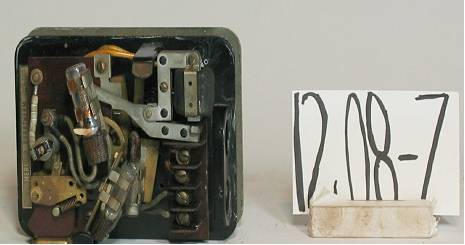Pressure Atomizing Oil Burner Equipment and Systems – Fuel Flow and Combustion Controls
A late 1920’s, one-piece, trend setting, automated combustion controller for oil fired, home heating systems, elegantly named the “Pyrotherm”, it was unitary in design, stack mounted, helical bimetal heat actuated, performing essentially the same functions as the earlier two-piece technology [See ID#231 and ID#229], but with greater precision. The device was a marvel of inter-connected mechanical, electrical and electro-magnetic components, operating three mercury bulb switches; Mercoid, Type 8M, Circa 1930.
Technical Significance:
– The “Pyrotherm”, introduced by Mercoid, an early innovator in the field of heating and refrigeration controllers, would trigger a world change, setting the stage for much of the next 30 years of combustion, safely control engineering
– The device was a marvel of inter-connected mechanical, electrical and electro-magnetic components, operating three mercury bulb switches
– A significant design consideration in the development of unitary, stack-mounted controls was the high ambient temperatures to which they were subjected. High temperature wiring and heat shielding were new design requirements to be dealt with.
– These embryonic, electric automated systems were representative of the earliest introduction of complex systems into the Canadian home. See Note #2
Industrial Significance:
– By the standards of that day the introduction of one-piece, compact, electro-magnetic combustion controllers represented a world change in precise engineering design and manufacture, requiring new materials and engineering know how.
– These control systems were a source of wonderment and no little fear for the Canadian public, as well as for many of the tradesmen who were called upon to understand, install and repair them, as well as to advise the homeowner on their proper, satisfactory operation.
– Mercoid, a name no doubt derived from the company’s reliance on mercury bulb switching, would prove to be a time honoured one in the HVACR field, as it evolved over the 20th century and into the next – see Dwyer Instruments web site


